Over the past year, organizations have managed upheavals on multiple fronts. “The Great Resignation,” continued uncertainty about remote working, and the general disarray caused by the COVID-19 pandemic means it’s time to check in with the most important aspect of L&D—learners themselves.
We surveyed 600 people in the United States who had benefited from training in their workplaces about their learning preferences. We then compared their answers to data collected from 2,310 HR and Training and Development professionals across the U.S., U.K., and France. We wanted to understand the challenges both groups are facing and explore some ways we can overcome them.
What follows are the main takeaways from our attempt to answer a crucial question: What do learners really want? (You can read the full study here)
1. Most learners find training useful and interesting, but satisfaction gaps still exist
The good news is that most employees rate their training and learning experience at work fairly positively. When asked, “How satisfied are you with the current training and learning opportunities available to you through your employer?”, the median answer was 76 on a scale of 1 to 100 (1 being very unsatisfied and 100 being very satisfied).
In addition, 67% and 62% of respondents described their training experiences as being “useful” and “interesting”, respectively.
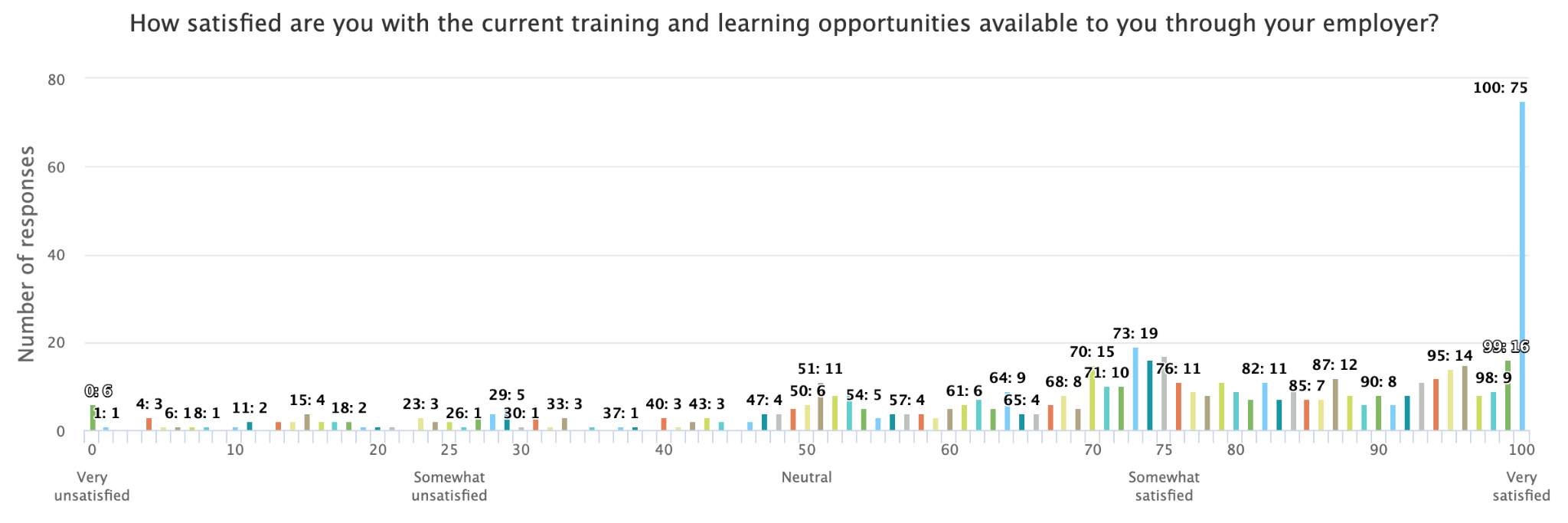
Yet there are some gaps in satisfaction levels, especially when we break down the data according to age and gender.
Younger generations are slightly less content with their learning experiences than their older counterparts. Those between the ages of 35 and 54 (older Millennials and Gen X) were the most satisfied and had a median score of 86.5. Those between the ages of 25 and 34 had a lower median score of 74.5, and those aged 18 to 24 had a median score of just 71. The Baby Boomer generation (those 54 and older) came in at 74.
The reason for these modest discrepancies is likely due to the way some companies have been conducting training in remote conditions. So, do digital native generations have expectations about (online) training that aren’t aligned with what some organizations are providing?
Gender also seems to play a role in satisfaction: Women were on average less satisfied with their learning and training experiences than men, with a median score of 72 vs 84. Is it possible that women perceive the training they receive as less valuable, comprehensive, or relevant? Or is it possible that the training experiences provided to women are in general of a lower quality than those provided to men? The question bears further study.
2. Main training hurdles include not enough time for training, not enough training, and training that isn’t relevant
When asked to elaborate on their feeling of satisfaction, respondents offered a range of answers.
When expressing dissatisfaction with their learning and training experiences at work, the most frequent responses included the fact that there wasn’t adequate time for training (especially during working hours), that there wasn’t enough training or that training wasn’t suitably comprehensive, or that training wasn’t relevant to their job or situation.
- “I’m really impressed with my organization but it’s difficult to find the time for training.”
- “We’ve been given some training but it’s just not enough.”
- “We are constantly offered opportunities, but most are not in line with my career.”
This lack of relevant and tailored training can be explained in large part by the time that it takes an average L&D team to produce one training course. In our survey of 2,310 HR decision-makers of those that use a learning platform, most said it took a day or more to create one course. 22% said it took about a month or more!
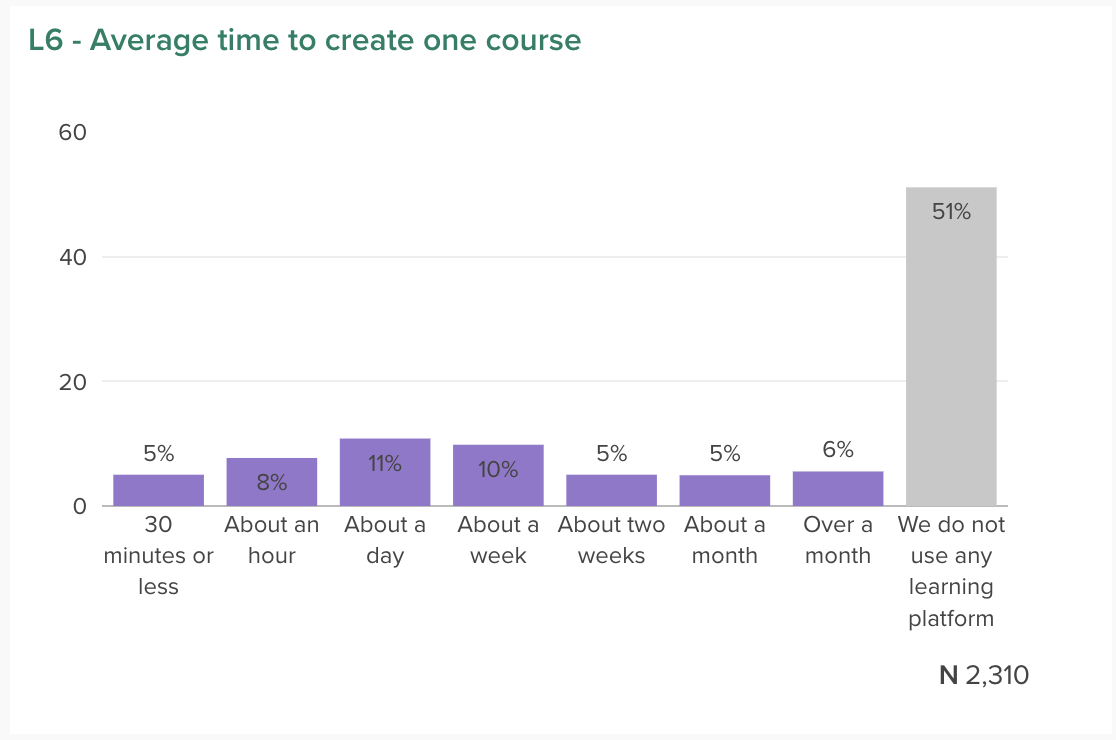
Depending on company and team size, this slow course creation time can make it very challenging to keep up with all learning requests. From the perspective of the learner, busy schedules, an overemphasis on productivity, and a lack of consideration for learning from leadership might make it difficult for them to find time for learning.
It is also highly likely that employers aren’t providing enough training in an ‘on the go’ format, like a mobile app or a video that can be watched on a smartphone. Providing training in the flow of work or that can be consumed in bite-sized chunks can help make it easier for employees to find the time to get the most out of the resources available to them.
3. L&D plays an important role in employee satisfaction
When asked, “How important are learning and training opportunities to your overall satisfaction with your job?” The median answer was 84 (out of 100). This supports the overall understanding that L&D serves a vital role in employee satisfaction and retention.
Those between the ages of 35 and 54 had a median score of 92 for this question, suggesting that those with their careers in full swing find training and learning particularly important. This may be because they’re more anxious about staying competitive in their field, or because they don’t want to get bored as they increase in experience.
Our data suggests younger generations find learning and training opportunities slightly less important (ages 18-34 had a median of 80). Those over 54 had a median of 80.5.
“They have more than enough training and most of it is mandatory. I’m not currently interested in more professional training as I’m towards the end of my career.”
4. Training for professional development is vital
Of all the different types of training, survey respondents seemed to have a particular appreciation for learning experiences aimed directly at supporting professional development:
- “I like the opportunities to grow.”
- “I receive funding for professional development each year and I also attend multiple trainings a year which is great.”
- “I work for a school district that provides many different opportunities for professional development on a variety of topics at no cost.”

On the flip side, over half (57%) of respondents said they’d leave a job if they felt they weren’t given enough professional development opportunities.
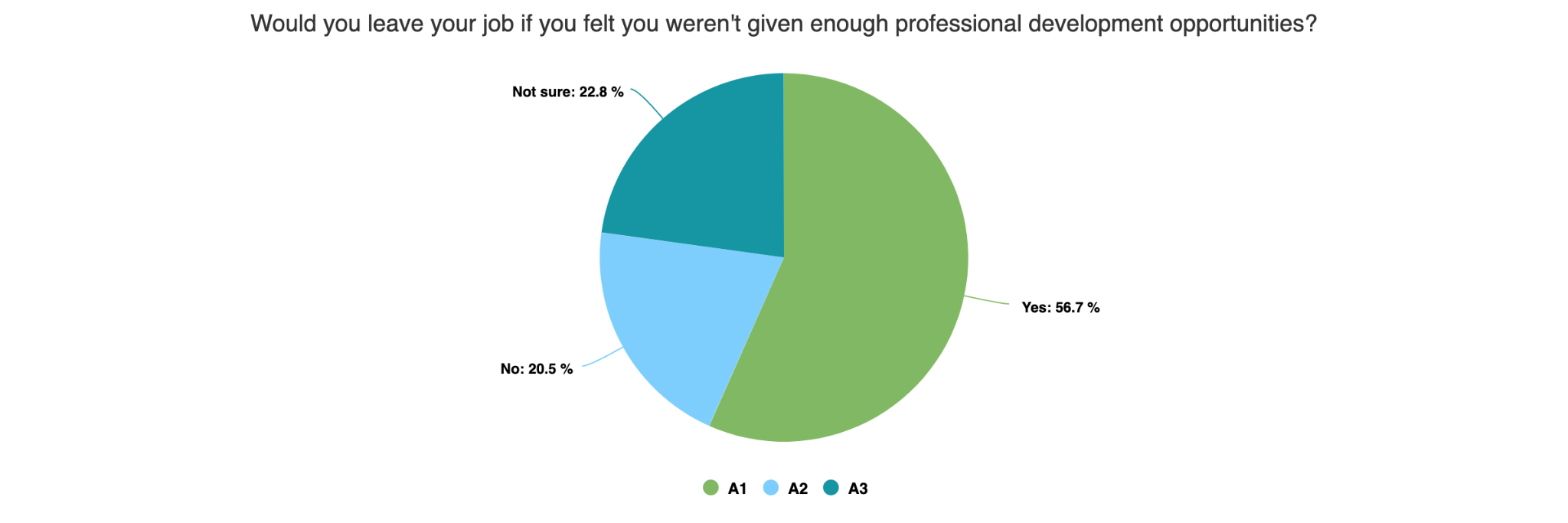
This data suggests there are clear learner expectations regarding professional development training opportunities: either make them available, or your teams will walk. Mentorship programs, manager training, or course creation based on subject-matter expertise are promising ways for L&D teams to bring a relevant professional development component to their training programs.
5. Companies need a better Blended Learning approach
When asked, “What type of workplace training or learning opportunities would benefit you most?”, most people said “in-person training”, followed by, “online, self-directed courses you can complete on your own”.
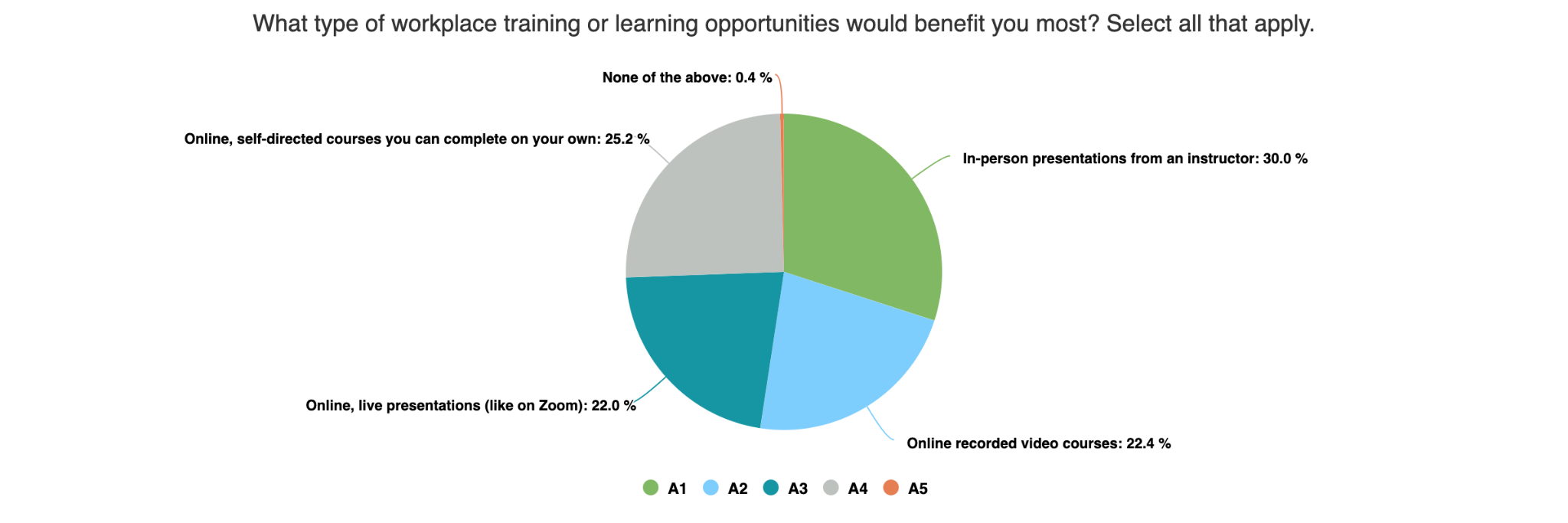
This likely reflects some remote workers’ desire for more in-person socialization; 70% of survey respondents are working at least partially remotely. This might also indicate that some respondents prefer a Blended Learning approach comprised of both synchronous live, and online, asynchronous learning opportunities.
But not all learning opportunities are equally appreciated:
- “I have had many online sessions that were great.”
- “Our training is web-based and boring.”
- “Remote training is ok, but having real face time with an instructor is better.”
In fact, 57% of respondents said that the training provided by their employers is “sometimes irrelevant, boring, or outdated”; 20% said that it “often” was, and 11% said it was irrelevant, boring, or outdated “all the time.”
- “They make you watch outdated and boring videos in the backroom and then consider that training.”
- “Sessions are too static and too short.”
- “They have training videos but not other support.”
- “A lot of information given, but no hands-on, follow up or discussion.”
- “We do some in-person which is good, but online training through Zoom is not so good.”
On the other hand, interactive learning experiences were considered positively, as was learning in the flow of work:
- “I really like the video trainings that we do. I love that they’re completed on shift and that we can ask our leaders questions about anything that we need help with!”
- “My employer believes in trainings and offers many to take on work time.”
- “The training is very hands-on and lets you learn what you need to.”
Responses suggest that employees appreciate a mixture of different media and training delivery formats, but that program creators aren’t always able to get the mix just right. This could be due to limitations in tools or resources, an LMS that is too rigid to allow for group interaction or collaboration, or a general unfamiliarity with digital learning.
Indeed, the biggest challenge identified by HR professionals responding to the survey was “moving training from in-person to online.” The path of least resistance for L&D teams is to directly transpose an in-person training session onto a virtual environment, like Zoom or Hangout.
Unfortunately, this approach rarely succeeds, since digital training spaces require a distinct approach for classroom management, and for creating interactivity, discussion, and collaboration. A simple copy and paste usually results in online sessions that are flat and ineffective.
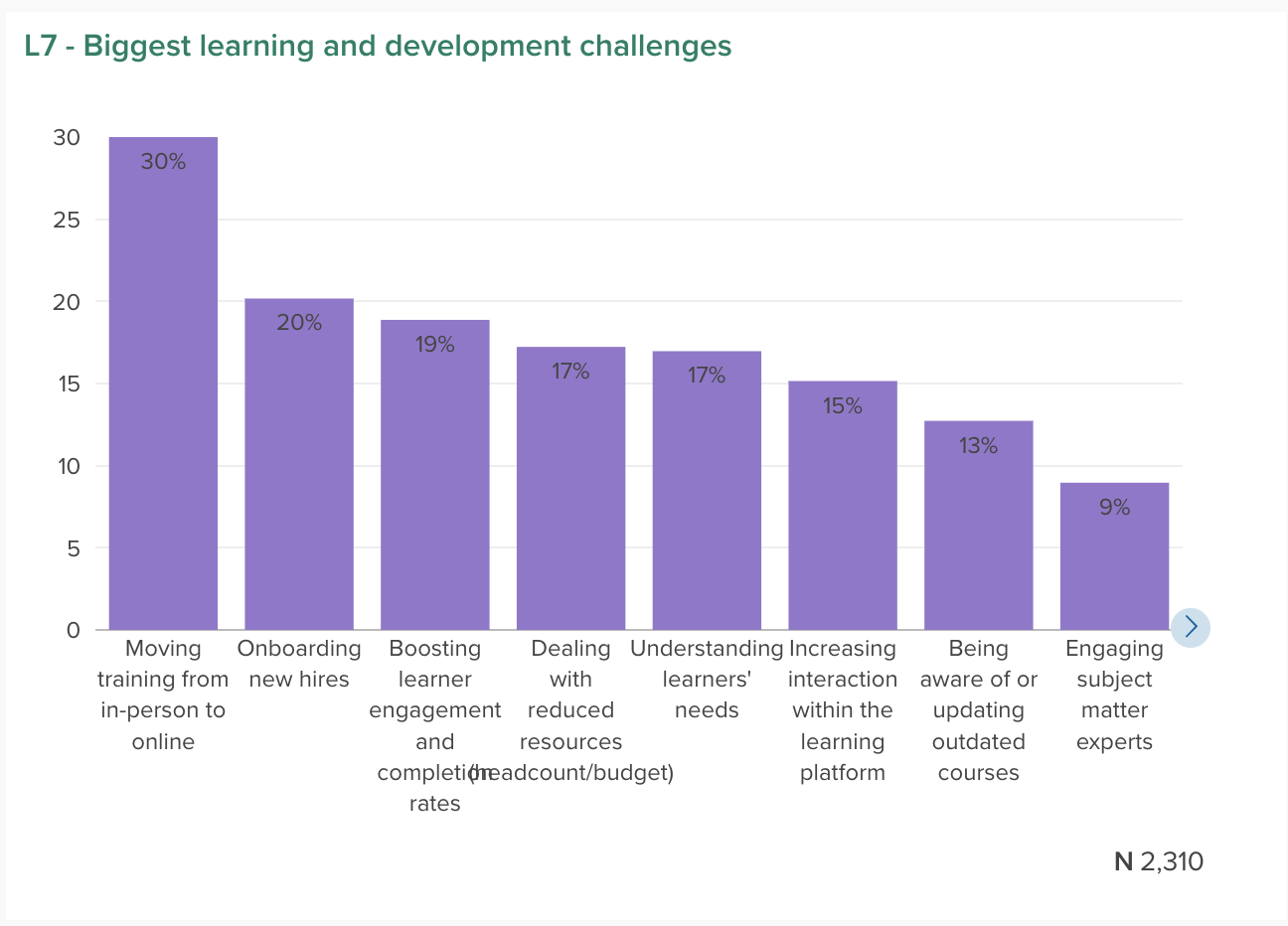
6. Employees are gaining new knowledge at work—but they’d like to learn even more
Most respondents say they learn something new at work weekly (37%)—32% even said daily.
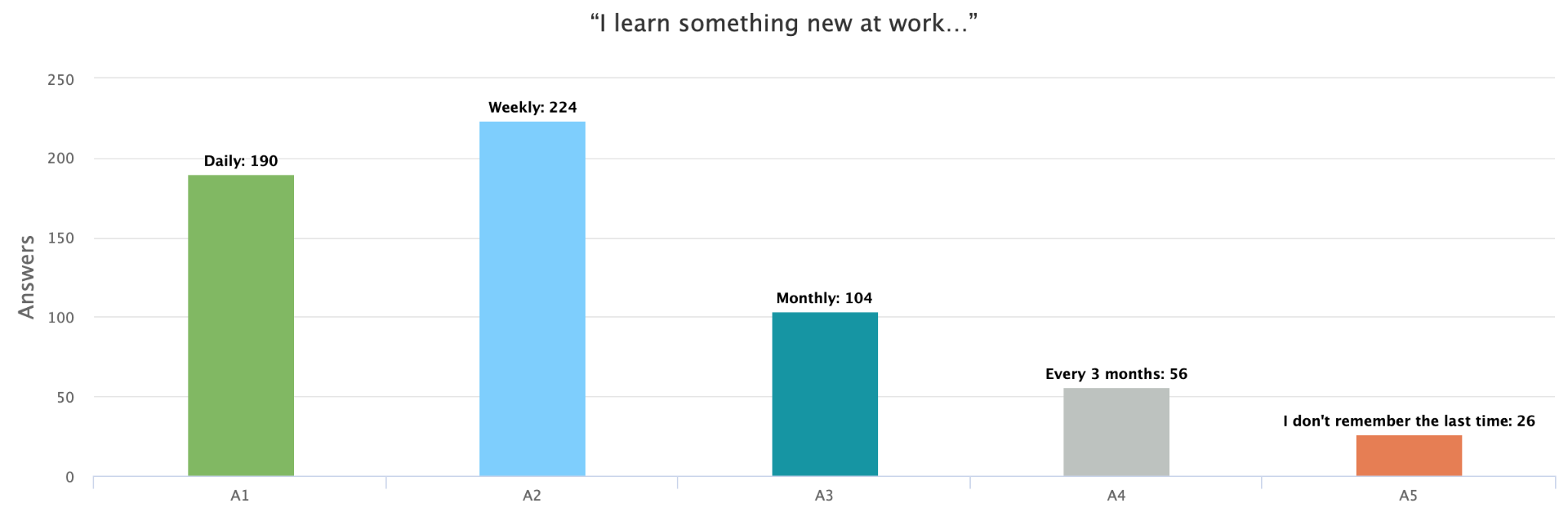

But when asked to elaborate, many employees said they want more comprehensive training:
- “I was offered food safety management training but outside of that there aren’t other opportunities to receive additional training.”
- “I think the company should offer more inclusive training but understand it can be a challenge now because of the pandemic.”
- “I feel fully equipped to handle my job for the most part. There could be more supplemental training or access to past training I feel that would be helpful.”
- “I like the trainings I have received, but I would like to receive more.”
- “Doesn’t feel adequate enough for what I need.”
- “We’ve been given some training but it’s just not enough.”
Certain respondents stated they receive little to no training, with some going so far as to train themselves to decrease their skills gaps without help from managers or L&D teams:
- “There is very little new hire training. I learned through third-party videos.”
- “With staff reductions we have to learn a new skill and no training just watch and learn.”
- “No training or learning opportunities are offered by my employer.”
- “It is almost nonexistent.”
- “Not much training and we had to fend for ourselves.”
- “I’m somewhat nervous that I’m only being taught enough to get by.”
- “Our training is extremely superficial and never includes all the information we need.”
- “I don’t really get training now I’m just left to figure it out myself.”
- “I usually get to attend one virtual conference a year. I usually find webinars and learning opportunities for myself.”
So, how is it that many employees aren’t getting the training they feel they need?
One answer could be organizations that don’t invest enough in their L&D departments. Another could be cumbersome course creation processes that don’t allow L&D teams to deliver courses in the time of need, and that make it hard to leverage existing subject-matter expertise. Or, it could be a culture of top-down Learning Needs analysis, where those deciding on the training programs don’t know what employees really need to excel.
7. Employees prefer to decide their own Learning Needs
To continue with the theme, when asked who should identify their Learning Needs, most (70%), said “myself”. The least chosen answer was ‘Executives’, which suggests there is a lot of appetite for decentralized learning strategies.
“My company offers a lot of different trainings throughout the year and regularly asks us what we’d like to learn.”
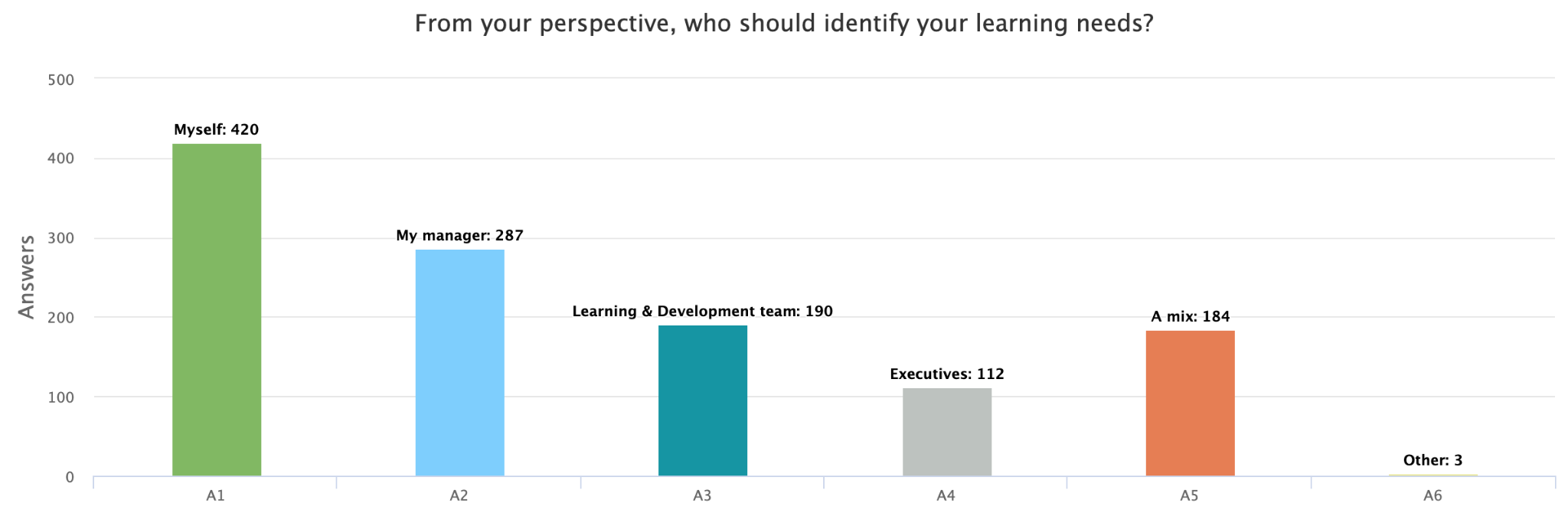
Generally, most respondents feel their work environment is too “top-down,” with upper management making most of the important decisions:
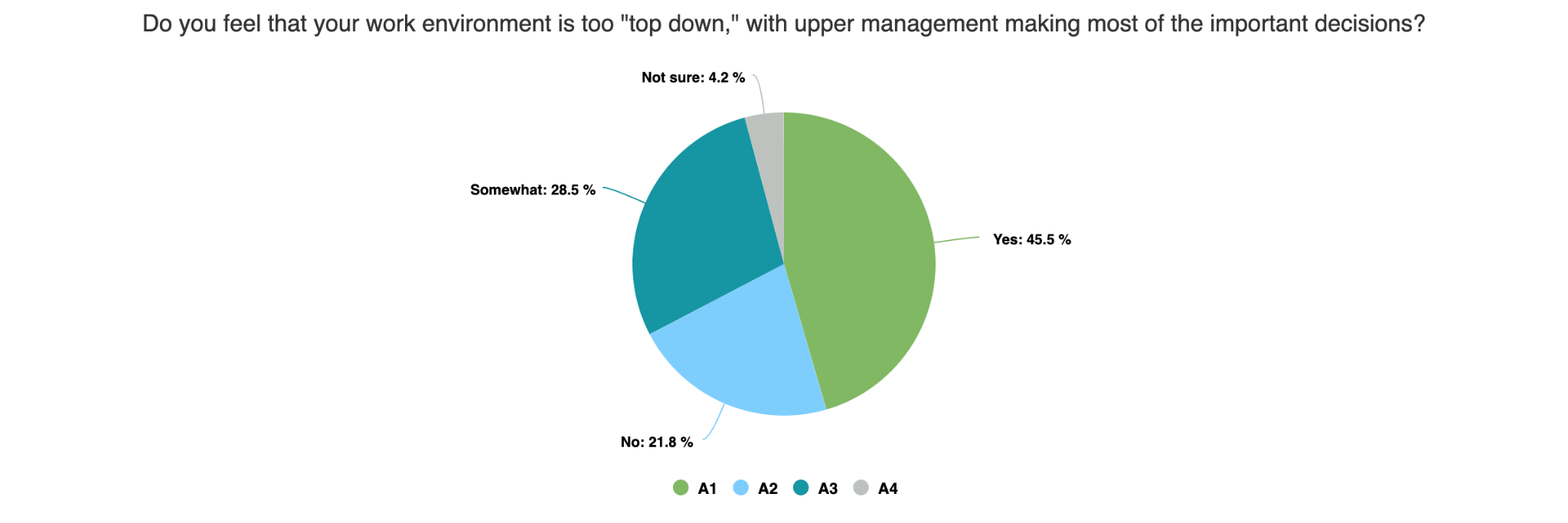
This could be a reflection of an across-the-board shift in work culture, with more organizations committing to a ‘bottom-up’ or ‘flat’ style of management.
8. Employers are asking for feedback on L&D experiences
On the bright side, respondents indicate that employers are often asking for their feedback about their training experiences (a median score of 73 out of 100), suggesting a growing commitment to iterate and improve the learning process:
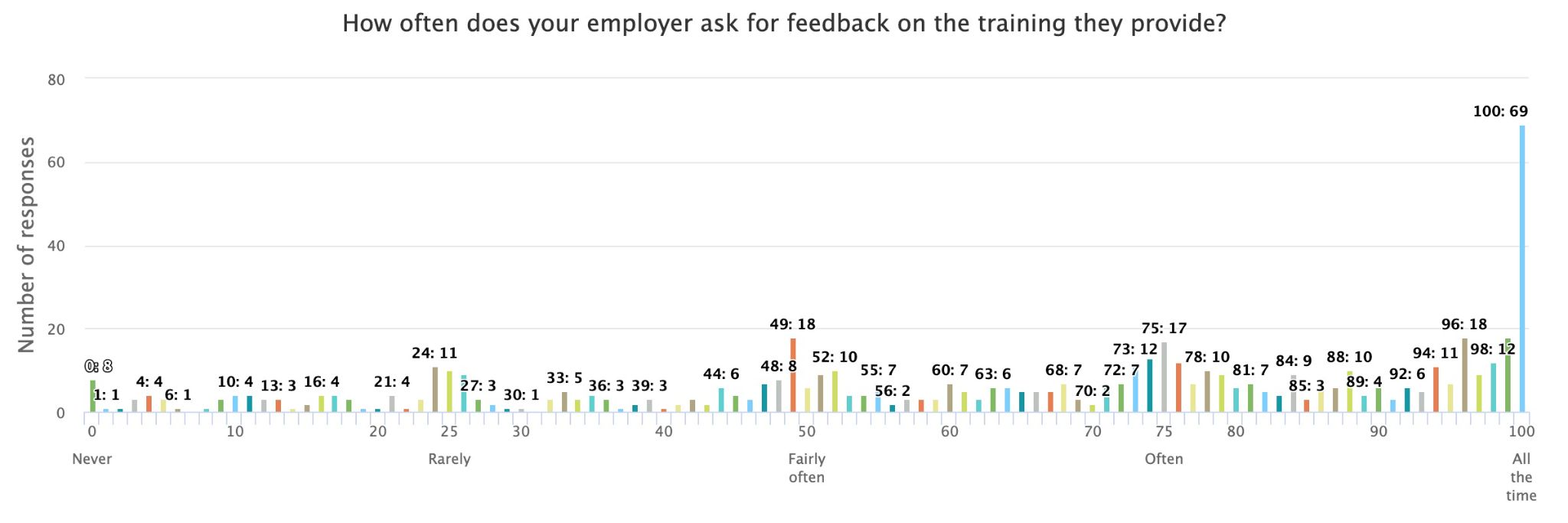
9. Most people want to learn more from their manager (and their peers)
The top two answers for the question “Who would you like to learn more from at work?” were “manager” and “peers”, with “L&D” not too far behind. This desire to learn more from colleagues indicates a growing interest in peer learning, and sharing the collective wisdom held by internal subject-matter experts. Wanting to learn from one’s manager could also show support for the 70-20-10 rule, which argues people tend to learn 70% of their knowledge from challenging experiences and assignments.

When enabled with the proper learning platform, peer learning is a time-efficient and engaging way for L&D teams to crowd-source course creation. Especially with the help of a built-in authoring tool, empowering individual contributors with subject-matter expertise to create and share courses not only benefits other learners, it’s also a validating experience for the course author, too.
10. Many organizations aren’t doing enough to tap into their valuable institutional knowledge
While respondents say they want to learn more from their peers and managers, they also say they themselves have untapped knowledge to offer, and they want to share it:
A majority (77%) of respondents say they have the knowledge to share but haven’t been asked to:

These results are encouraging; they suggest organizations can improve their knowledge capture and transmission just by investing in the right tools. The solution to many of the challenges facing learners and L&D teams might already be at our fingertips: learners’ own institutional knowledge.
Collaborative Learning is making inroads—and increased adoption can address frequent learner and L&D challenges
Learners’ appetite for peer learning, interactive learning, and learning in the flow of work, as well as a bottom-up approach to training needs analysis, are strong signs that today’s employees want more Collaborative Learning experiences. A Collaborative Learning approach would be an effective and efficient way to address many of the gaps in learner satisfaction, including:
- Insufficient or irrelevant training,
- Unengaging training formats,
- Lack of time and resources for L&D teams,
- Lack of peer-to-peer interaction or peer learning (especially from manager to their direct reports),
- Top-down approaches to determining Learning Needs.
In Collaborative Learning, subject-matter experts, with the guiding hand of the L&D team, engage in course creation and iteration, based on a bottom-up Learning Needs analysis.
Not only does relying on this institutional knowledge render courses more contextually relevant and engaging, but it takes much of the burden of course creation from L&D, enabling them to deliver more relevant training, faster. Consider that most HR professionals that create training courses say that only 1-5% of their employees help them to create course material.
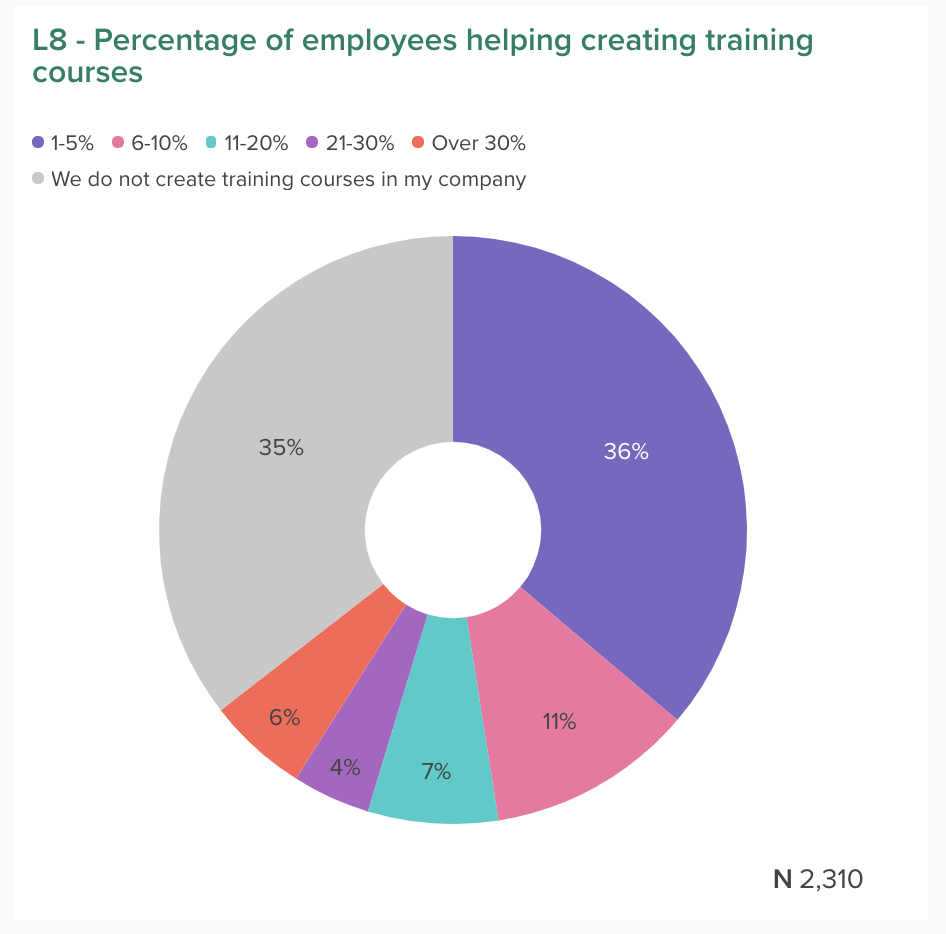
Fast, peer-based, and scalable Collaborative Learning doesn’t just keep your teams happy and engaged: it also helps L&D teams save time on low-value administrative tasks like updating old content, scheduling courses, and tracking completions.
More than that, it helps your organization respond to opportunities for innovation and invention.
Collaborative Learning achieves this by:
- Making it easy for people to declare their learning needs
- Empowering any team to make and ship courses quickly in response
- Shaping learner recommendations based on user data relating to skills, interests,role, feedback from other learners, and more
- Encourage subject-matter experts to contribute their skills, share their knowledge,and iterate learning content over time
- Enabling L&D teams to build tailored programs by curating courses from 3rd party platforms – including existing SCORM libraries
- Using a continuous feedback loop to keep learning content current, accurate,and engaging
- Fostering a shared sense of connection and belonging through making everystep of the learning process as interactive as possible
If you’re facing some of the same challenges described above, it’s highly likely adopting a Collaborative Learning approach would help.
—–
Interested in learning more about how you can future proof your workforce? Watch the on-demand replay of our recent virtual summit, “Skills Matter: What Your Organization Needs to Survive and Thrive.”
Enjoyed reading this blog? Leave feedback for us and subscribe to our newsletter, HR matters.
Data in this report was taken from two separate sources. The first was a survey conducted by 360Learning of 600 adults in the United States on July 31, 2021, who had received training from their employer. The second was a survey conducted by 360Learning of HR and Training and Development decision-makers in the U.S. (1001), U.K. (1008), and France (301) between July 13th and 19th, 2021.
